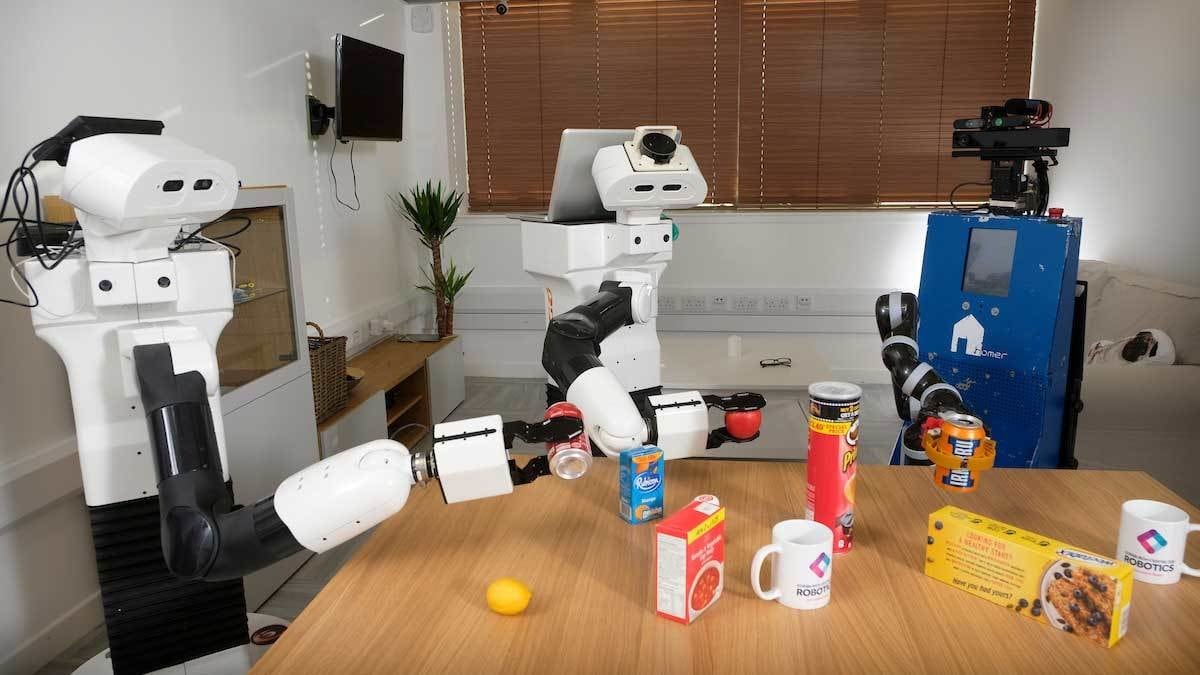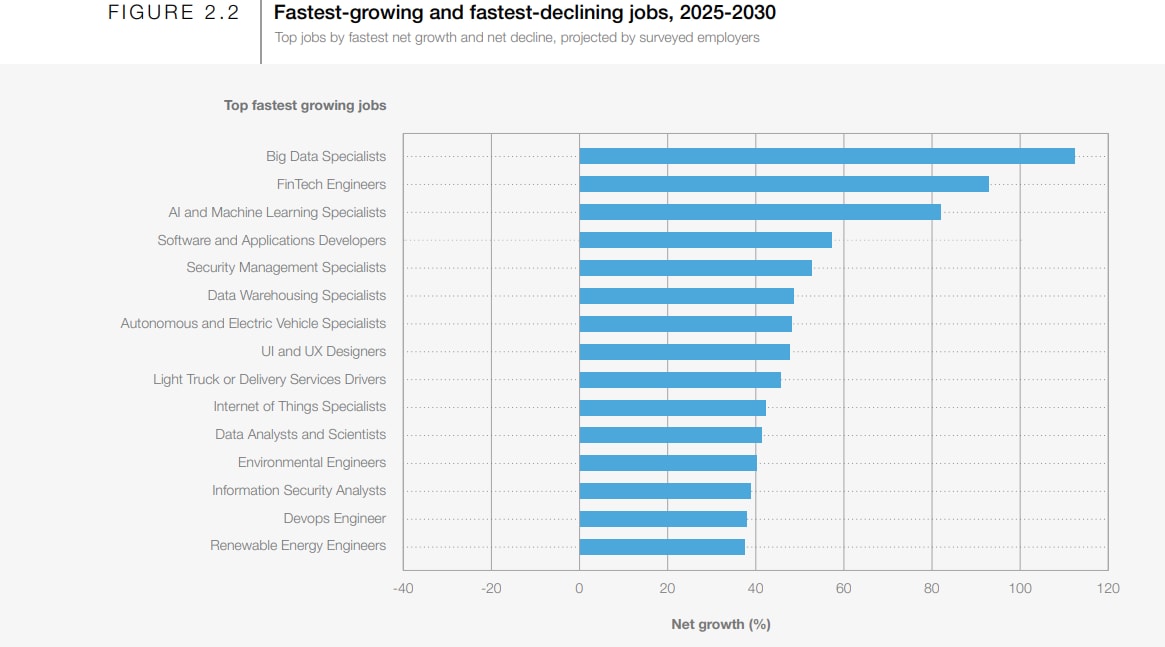From robotic dogs to magnetic slime: 9 ways robots are helping humans

In numerous settings around the world, robots – often teamed with artificial intelligence (AI) – are helping humans with a range of tasks. Image: Archaeological Park of Pompeii
Listen to the article
This article has been updated.
- Robots are helping humans in a growing number of places – from archaeological sites to disaster zones and sewers.
- The most recent robotic inventions can entertain people in care homes and squeeze into small spaces.
- Robotics engineers are among the top 20 job types on a growth trajectory, according to the World Economic Forum's Future of Jobs Report 2025.
Workplace robots are often associated with pushing human workers out of their jobs.
But in numerous settings around the world, robots – often teamed with artificial intelligence (AI) – are helping humans with a range of tasks. This includes high-risk and complex jobs, and work in places where humans can’t go.
Here are nine examples.
Pompeii’s robot dog
In the ancient Roman ruins of Pompeii, a robot dog called Spot carries out safety patrols.
The four-legged robot can inspect “even the smallest of spaces in complete safety”, says the Archaeological Park of Pompeii, which looks after conservation for the site near Naples in Italy.
Spot also helps inspect underground tunnels dug by illegal relic hunters that are being uncovered around Pompeii. The city and its 20,000 inhabitants were buried when Mount Vesuvius erupted in AD79. The data Spot records will help his human colleagues manage the safety of the site and its workers.
Robots on the Moon
If humanity achieves the aim of building a base on the lunar surface, the intrepid crews that will live there are going to need some extra help. A team at the Harvard John A Paulson School of Engineering and Applied Sciences in the US is focused on developing autonomous robots that can repair and replace damaged components on this future space station.
The main challenge is designing multifunctional robots that can do a variety of different tasks. And to achieve this, they are modelling them on the human hand.
“Human hands can adapt to many functions, including those that need high precision, require high forces, or those that may benefit from compliance,” said one of the researchers. “This design attempts to capture analogous adaptable behaviour to increase the range of tasks possible with a single gripper.”
Robotics in social care
In Scotland, an assisted living lab that looks like a real home has been created at the National Robotarium. Scientists there are using robotics, AI and sensor technologies to carry out functions like monitoring long-term health conditions. Technology can also help people with tasks like making phone calls, switching on lights, opening doors and watching TV.
The aim is to help people live more independently and also to give carers a break. Scotland has 1.1 million unpaid carers, according to the National Robotarium, and a fifth of them say they haven’t had any time off in more than five years.
Globally, nurses and carers are in increasingly short supply and robots are seen as a possible solution to the staffing crisis. In Geneva, a social robot powered by generative AI told Reuters it had sung and played bingo with residents at a nursing home in Singapore.
While in Oxfordshire in the UK, robots are being used to help occupational therapists develop their skills around touch and communication. The robot is programmed to respond based on specific health profiles and behaviours, so that professionals can practice individualized responses to ensure best outcomes in a variety of situations.

How is the World Economic Forum ensuring the responsible use of technology?
Robots as worksite assistants
The Atlas robot shot to internet fame in August 2021 after popping some parkour moves for a YouTube video. A later clip of the robotic assistant might not be as amusing, but the company behind it, Boston Dynamics, says it represents much more of a breakthrough.
It shows the robot grabbing a tool bag for a worker who is located on an elevated platform, constructing a walkway using a wooden plank in order to reach the worker, then throwing the bag to the worker.
Sounds simple? Well it's not. Getting a robot to accurately throw something rather than just jump around involves giving it an awareness of what will happen when it applies forces to objects. In other words, you have to make it understand Newton’s third law – that every action has an equal and opposite reaction, Boston Dynamics says.
So what's next for Atlas? "Making smart decisions about how to move through the world ... will be essential for turning Atlas into a robot that can do meaningful work outside of the lab," its creators say.
Soft robots for tight spots
Robots come in all shapes and sizes. At the Chinese University of Hong Kong, scientists have discovered uses for a robot made from slime, the New Scientist reported.
The robot is described as the consistency of custard. But it has been mixed with magnetic particles that can be moved and controlled using external magnets. Because it’s soft, the slime can squeeze through narrow spaces with a 1.5mm diameter and grasp solid objects by wrapping around them.
In machines, the slime can perform functions like repairing circuits, the researchers say in the journal Advanced Functional Materials. In humans, the slime can potentially “swallow and transport harmful things” – like a dangerous object ingested by mistake.
Search and rescue robots
In disaster zones that are hard to reach and dangerous to human life, robots provide invaluable support to human search and rescue teams.
In China, the world's smallest and lightest wireless robot has been developed that can shift its shape and operate on land or in the air, making it potentially a useful ally in disaster and rescue situations, reports the South China Morning Post.
MIT researchers in the US have created a "vine robot", SPROUT (Soft Pathfinding Robotic Observation Unit), which can not only navigate tight spots but can extend itself up to 10 feet. With its built-in camera, it can be used to pinpoint the exact location of trapped survivors after a building collapse.
Underground robots
Sewers are another setting where robots are helping humans tackle tough jobs.
Fatbergs – big lumps of fat, wipes and other items that have been flushed down drains – are a growing problem. They clog up water pipes and can cause floods.
Sewer Robotics, a company in the Netherlands, specializes in making crawler robots that inspect, clean, cut and maintain underground pipes. Its robots are armed with high-pressure water jets that can break up fatbergs.
Robots for the energy transition
Green technology needs maintenance and inspection – but imagine the challenge of checking all the bolts on wind turbines.
A UK project has developed a six-legged robot to take the job on. The robot can autonomously inspect the bolts, eliminating the need for humans to loosen and retighten them, reports Marine Technology News.
The project could save hundreds of millions of dollars in Europe each year, alone, while also extending turbine life spans and reducing the risks faced by human workers.
Farming robots
US company Verdant Robotics has developed a robot to help farmers with both yield and sustainability. The SharpShooter can weed, fertilize and tackle disease in crops with pinpoint accuracy, as well as collect data on the whole farm down to the plant level. Its developers say it'll help cut pesticide use through their "precision agriculture" model.
Agritech is a growing industry, and the technology is constantly evolving to help farmers produce more food for ever more people. It can also help address labour shortages, as is the case with the next generation of strawberry-picking robots being trialled in the UK. Using AI, these robots can not only identify ripe strawberries, but can also carefully pick and package them in seconds, reports the University of Essex, which is leading the trial.

Innovations in the field
Given the above examples, it's perhaps no surprise that robotics engineers are among the top 20 job types identified in the World Economic Forum's Future of Jobs Report 2025 as projected to increase between now and 2030.
Innovations in this area – and other technologies – are highlighted in the Forum's selection of 100 Technology Pioneers for 2025. Three of the chosen start-ups are using advanced robotics:
CynLr is building robots with intuitive vision to enable fully automated factories.
Robocon is also focusing on smart factory solutions, this time specifically for the construction and steel industries.
RoboForce is creating AI-powered robotic systems for either high-risk or repetitive work to enhance both safety and productivity.
The pioneers will now embark on a two-year programme with the Forum to scale up their inventions.
Don't miss any update on this topic
Create a free account and access your personalized content collection with our latest publications and analyses.
License and Republishing
World Economic Forum articles may be republished in accordance with the Creative Commons Attribution-NonCommercial-NoDerivatives 4.0 International Public License, and in accordance with our Terms of Use.
The views expressed in this article are those of the author alone and not the World Economic Forum.
Stay up to date:
Virtual and Augmented Reality
Forum Stories newsletter
Bringing you weekly curated insights and analysis on the global issues that matter.
More on Emerging TechnologiesSee all
Whitney Wellington and Elia Resch
December 12, 2025







